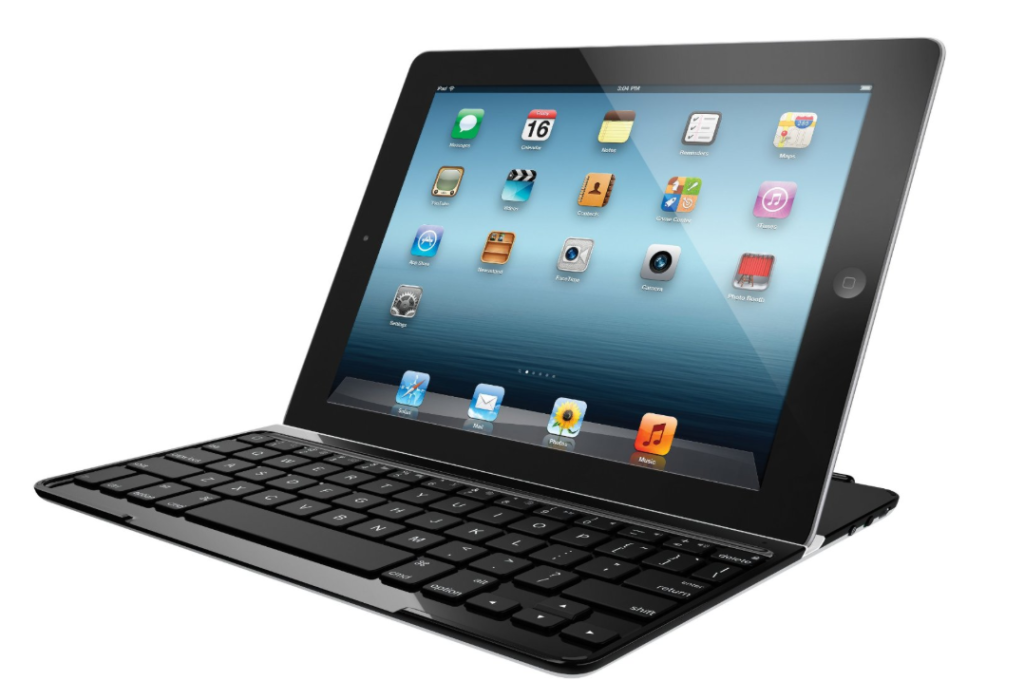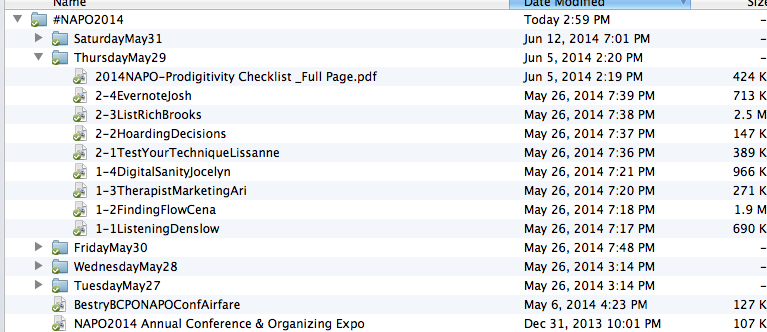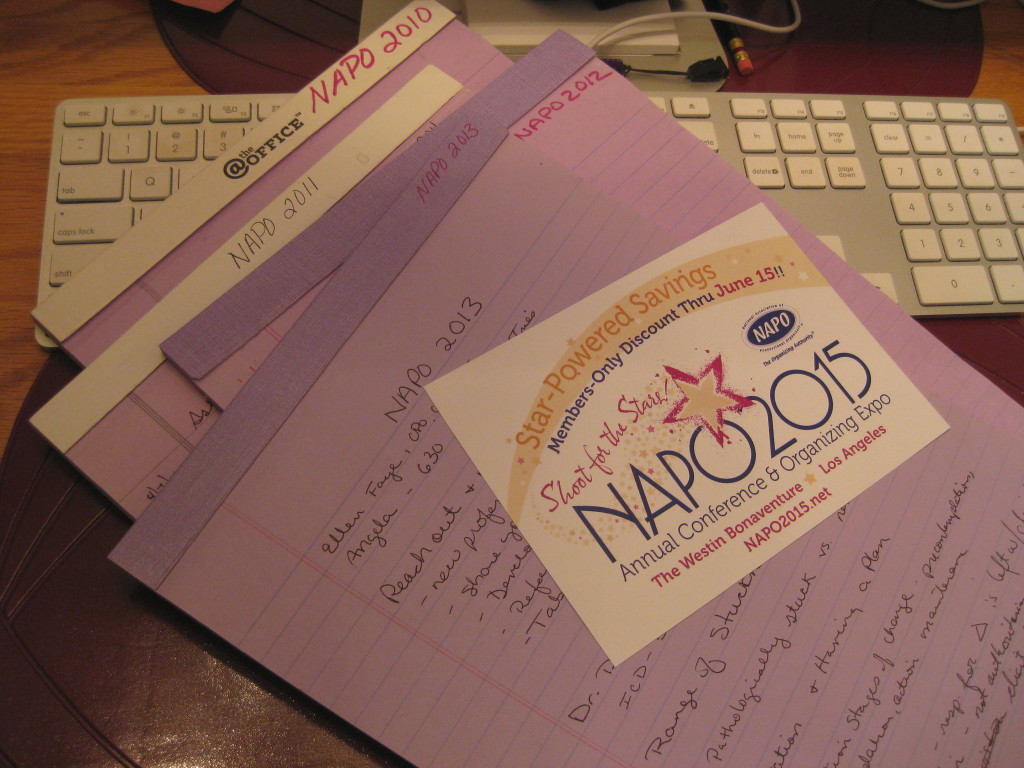NAPO2014: Taking Notes–The Paperless Experiment
The speed at which tech is adopted may be faster than makes us comfortable. At the 2009 National Association of Professional Organizers Annual Conference and Expo, I looked around a huge meeting room and noticed a significant number of professional organizers taking notes on laptops. A few years later, it seemed like the majority of attendees were using tablets and even phones for the same purpose. At the 2013 conference, I had a spanking-new iPad, and while I could be much more productive in terms of checking email while away, there was no way I could take meaningful notes on a touch screen. I felt like a productivity impostor!
THE EXPERIMENT
This year, I arrived at our conference with a keyboard and a plan. The keyboard, a Logitech Ultrathin Keyboard Cover, is bluetooth (that is, magic) and thus wireless, very low-profile (i.e., flat),
and when not in use, attaches to the iPad with high-powered magnets and acts as a hard-shell front cover/case. I’d spent a ridiculous year doing research, comparing aesthetics and keyboard “feel” before selecting the Logitech.
The plan was to try something I’d never done before, to go paperless for an entire NAPO conference. To do that, I’d have to:
- Take notes digitally
- Print nothing
- Figure out how to integrate different input sources of information
I decided immediately that for taking notes digitally, I would use Evernote. In my post, Understanding Evernote: What, Why and How, I’d written about all the ways in which Evernote can optimize the notetaking experience, with audio notes, formatting, and more, and I’ve used it in various board meetings and occasionally with clients. But this would be the first time in thirteen years of attending the NAPO conference that I hadn’t taken copious notes on purple writing pads to maintain a complete paper transcript of my experience.
In lieu of purchasing the hard-copy conference book (containing session handouts, schedules and other information) or printing downloaded pages, I opted to use the NAPO 2014 Conference App, an interactive mobile app for building a schedule and accessing session information with a tap of the screen. I also downloaded the handouts for each intriguing concurrent sessions to Dropbox, grouping them by session date. I’m usually torn between, at most, two concurrent sessions, but Thursday, May 29th offered myriad fascinations.
Certainly, I could have uploaded the handouts to Evernote, but I wasn’t experienced enough to know how difficult it would be to switch between two different notes in Evernote, speedily. Deb Lee and Nanette Duffey recommended apps like PDF Cabinet and Notability, which let you annotate, or take notes directly on PDFs. However, I tend to take extensive notes with my own quirky notetaking style, and I wasn’t ready for this experiment to get too audacious.
THE COMPLICATIONS
My biggest fear, that we’d be (as we often are) packed tightly in rows of chairs without writing surfaces or adequate space, was immediately allayed. The Westin-Kierland outfitted us with nice tables and ample space between attendees, so whether I’d have used paper handouts and a writing pad or my keyboard (as I did), the physical circumstances were ideal.
Although I do have a nifty app called Side By Side, which allows up to four different apps running simultaneously on split screens, the learning curve proved a bit too steep, and the individual viewing panels were too small for the session handouts.
In the end, there was no way for me to keep my own notetaking style and see both my notes and the handouts simultaneously. I also found that swiping from (Evernote) screen to (Dropbox) screen and back again did not work smoothly, and when certain pages of one session’s notes in Dropbox somehow saved to PDF sideways, I had to include the conference app in the swiping equation.
“You look like you’re trying to conduct an orchestra!” a colleague giggled. Sigh…
Thus, I found double-clicking the Home button to see all open apps and sliding back and forth between them was my best solution for flipping from various handouts to the Evernote screen and back again.
WHAT ABOUT COGNITION?
Over the course of a few weeks leading up to and following the NAPO conference, the media was abuzz with the findings of “The Pen Is Mightier Than the Keyboard: Advantages of Longhand Over Laptop Note Taking“ in the June issue of Psychological Science. The basic takeaway? Our brains process our handwritten information differently, and we learn better (and more) through handwriting. For more depth on the subject, you can review:
- The New York Times: What’s Lost As Handwriting Fades?
- Canadian Journal of Learning and Technology: Exploring the Benefits and Challenges of Using Laptop Computers in Higher Education Classrooms
- Scientific American: A Learning Secret: Don’t Take Notes With a Laptop
Typing notes leads us to write more, because we can type faster than we hand-write. (Well, Paper Mommy notwithstanding.) The faster we can type, the more likely we are to write everything we hear. However, if we write everything, we tend not to think about what we’re hearing, process it and summarize it, as we are more likely to do when handwriting. So, if I understand the basis of the research, it’s the inefficiency of handwriting that increases our ability to learn!
However, all of the studies are based on academic learning, where information is generally new. In professional settings, the information presented tends to be a mixture of new material combined with familiar concepts. And much of the new knowledge, particularly in terms of the technology sessions, would really require hands-on experience to provide more than cursory awareness to take hold in our brains. The matter is far from closed.
THE RESULTS
Overall, my paperless experience at this year’s conference was a positive one in the moment.
- Because I can type without looking at the screen (but can’t handwrite the same way), I was able to pay attention to each speaker’s non-verbal communication in greater depth.
- I was certainly able to type faster than I’d ever been able to handwrite my notes, giving me the opportunity to scan and correct errors without missing what the speaker was saying.
- My notes are far more legible than in past years.
- The jury is still out on the neurological connection. I have a pretty good memory, and most of the concepts at conference were not so very complex or novel that I fear my ability to learn and understand the material was compromised.
However, I’m finding the paperless route to be challenging in other ways.
- As a touch-typist, I know I can type what I’m hearing without even reading what’s on the screen, so although I received more non-verbal communication, I lost that simultaneous one-two punch of listening and reading for a more robust learning experience.
- I missed the ability to write epiphanies in the left-hand margin, sometimes on the diagonal, and use my personal “scribble” codes. I know I can learn how to type a Greek Delta (it looks like a triangle, and means “change”), or color-code in Evernote, but no matter how few keystrokes it takes, it’s just not the same.
- The tactile experience carries over to the post-conference experience. Normally, I flip through my purple writing pads many, many times over the course of the weeks following conference to review both content and goals. Much of the time, I advise clients to use tickler files to encourage them to file, and then go in search of, items they wish to review, but at least in the immediate aftermath of conference, it’s helpful to have the notes physically nearby.
- I generally use notations in the margins to prompt session-related follow-up, and the back pages of the writing pad to keep a running list of non-session inspiration (e.g., “Make connections with Professional Organizer X,” “Try software package Y,” “Experiment with marketing technique Z”). There’s no technological reason why I couldn’t have had an Evernote note for such critical thoughts, but again, for some purposes, handwriting them, and reviewing them soon after the fact, is more than my custom — it’s what works best for me, cognitively and motivationally.
- Digital distractions were overwhelming. Even though I tried hard not to Tweet during sessions except to share a particularly brilliant insight, notifications from Twitter, Facebook and iMessage split my attention between the session I was attending and the sessions I wished I were also attending.
- As a professional organizer, I spend much of my days working with clients who are uncomfortable with tossing their 25+ year-old college notes. Nonetheless, I have confidence in paper. Evernote, while fiscally and technologically strong, may not last forever. Just in recent weeks, we’ve seen Manilla and Springpad shut down and users struggling to safely export their data. At the periphery of my comfort zone, I realize that I don’t have the same innate confidence in Evernote as I do in my purple pads.
Will I continue to use Evernote? Absolutely. But at the risk of seeming like an old dog (supported by academic, and now personal, research), I may save my new tricks for taking notes elsewhere than the NAPO annual conference.
Next time, we’ll be looking at Pendaflex/TOPS’ new Focus Notes™, a traditional notebook for taking handwritten notes, based on my beloved Cornell Note-Taking System.







Loved reading your experience, and being able to compare to mine!
I was a first time NAPO Conference attendee, so my paperless adventure had no history to unlearn or feel the impact of missing.
Some ways I addressed some of the pain points you raised:
1) Any time I had an epiphany or thought, I typed it in the text, with two asterisks before and after it. I was able to then spot these later, and collect them elsewhere, as I was reviewing my notes.
2) I kept an “Action List” note active, and could relatively quickly switch to another note to keep THOSE items in place.
I’m also a touch typist, but do very well with touch-screen typing. I had a keyboard that I did not bring with me, but believe I would next time, just to increase my effectiveness with it.
3) I used the slides that were included in the NAPO app, and kept them up that way. Often I used my phone on one side of my iPad to simulate a two-screen environment. If I had paper, I’d probably jot notes in the slides, but I don’t actually know that i’d DO anything with the slides later on. Now that I have the notes in Evernote, they’re’ a lot easier to search, access, edit, reformat into a new document, share, etc. I would never have done that with annotated paper slides.
Honestly, I wasn’t a HUGE Evernote user before Conference. I capture notes once or twice a week in it, and clip websites to it, but this was the most concentrated time I’d had in the system. I would recommend to anyone thinking they are going to get immersed in Evernote for a conference to get as familiar with it as they can BEFORE going. “In the moment” is no time for a learning curve.
Thanks for you great update!
[…] That changed when I attend the recent NAPO conference. For several sessions, I sat next to my friend and colleague Julie Bestry, and I watched her take notes on her iPad using an external keyboard. I was very impressed how the notes were organized on her iPad. I asked her what app she was using, and she responded, “Evernote.” (To read about Julie’s note-taking experiment, see her blog post.) […]
[…] Julie Bestry from Best Results Organizing did a great blog post about her experience at a recent conference that I spoke at in Phoenix: NAPO2014: Taking Notes–The Paperless Experiment. […]